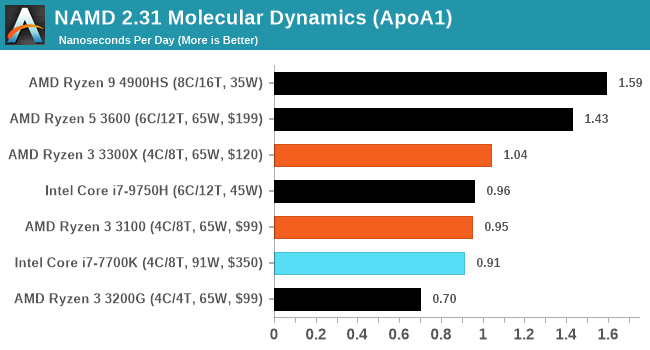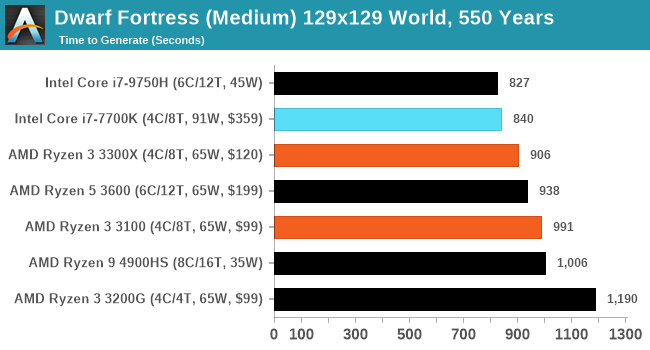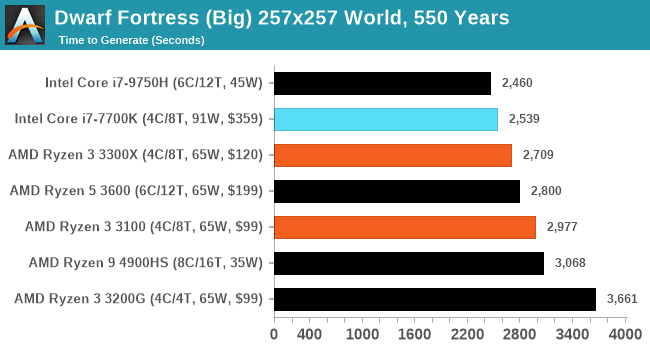The AMD Ryzen 3 3300X and 3100 CPU Review: A Budget Gaming Bonanza
by Dr. Ian Cutress on May 7, 2020 9:00 AM ESTCPU Performance: New Tests!
As part of our ever on-going march towards a better rounded view of the performance of these processors, we have a few new tests for you that we’ve been cooking in the lab. Some of these new benchmarks provide obvious talking points, others are just a bit of fun. Most of them are so new we’ve only run them on a few processors so far. It will be interesting to hear your feedback!
NAMD ApoA1
One frequent request over the years has been for some form of molecular dynamics simulation. Molecular dynamics forms the basis of a lot of computational biology and chemistry when modeling specific molecules, enabling researchers to find low energy configurations or potential active binding sites, especially when looking at larger proteins. We’re using the NAMD software here, or Nanoscale Molecular Dynamics, often cited for its parallel efficiency. Unfortunately the version we’re using is limited to 64 threads on Windows, but we can still use it to analyze our processors. We’re simulating the ApoA1 protein for 10 minutes, and reporting back the ‘nanoseconds per day’ that our processor can simulate. Molecular dynamics is so complex that yes, you can spend a day simply calculating a nanosecond of molecular movement.

Crysis CPU Render
One of the most oft used memes in computer gaming is ‘Can It Run Crysis?’. The original 2007 game, built in the Crytek engine by Crytek, was heralded as a computationally complex title for the hardware at the time and several years after, suggesting that a user needed graphics hardware from the future in order to run it. Fast forward over a decade, and the game runs fairly easily on modern GPUs, but we can also apply the same concept to pure CPU rendering – can the CPU render Crysis? Since 64 core processors entered the market, one can dream. We built a benchmark to see whether the hardware can.
Smooth#canitruncrysis pic.twitter.com/k7x31ULndF
— 𝐷𝑟. 𝐼𝑎𝑛 𝐶𝑢𝑡𝑟𝑒𝑠𝑠 (@IanCutress) May 4, 2020
For this test, we’re running Crysis’ own GPU benchmark, but in CPU render mode. This is a 2000 frame test, which we run over a series of resolutions from 800x600 up to 1920x1080.
| Crysis CPU Render Frames Per Second |
||||||
| AnandTech | 800 x600 |
1024 x768 |
1280 x800 |
1366 x768 |
1600 x900 |
1920 x1080 |
| AMD | ||||||
| Ryzen 9 4900HS | 11.50 | 8.75 | 7.44 | 6.83 | 5.21 | 4.30 |
| Ryzen 5 3600 | 9.98 | 7.84 | 6.69 | 6.15 | 4.75 | 3.92 |
| Ryzen 3 3300X | 8.42 | 6.52 | 5.43 | 5.01 | 3.92 | 3.07 |
| Ryzen 3 3100 | 7.50 | 5.78 | 4.87 | 4.5 | 3.54 | 2.77 |
| Intel | ||||||
| Core i7-7700K | 7.63 | 5.87 | 4.95 | 4.55 | 3.57 | 2.79 |
| Core i7-9750H | 6.78 | 5.17 | 4.37 | 3.99 | 3.12 | 2.46 |
Dwarf Fortress
Another long standing request for our benchmark suite has been Dwarf Fortress, a popular management/roguelike indie video game, first launched in 2006. Emulating the ASCII interfaces of old, this title is a rather complex beast, which can generate environments subject to millennia of rule, famous faces, peasants, and key historical figures and events. The further you get into the game, depending on the size of the world, the slower it becomes.
DFMark is a benchmark built by vorsgren on the Bay12Forums that gives two different modes built on DFHack: world generation and embark. These tests can be configured, but range anywhere from 3 minutes to several hours. I’ve barely scratched the surface here, but after analyzing the test, we ended up going for three different world generation sizes.



Interestingly Intel's hardware likes Dwarf Fortress.
We also have other benchmarks in the wings, such as AI Benchmark (ETH), LINPACK, and V-Ray, however they still require a bit of tweaking to get working it seems.










249 Comments
View All Comments
Spunjji - Monday, May 11, 2020 - link
You missed out on what Userbenchmark would add. Luckily most of us know the answer is "nothing".I'm now pretty convinced that you're a Deicidium sockpuppet.
Spunjji - Monday, May 11, 2020 - link
Oh for crying out loud. The first two posts in the comments wasted on a feckless simpleton blubbering that this site doesn't do the exact same things every other site does.Guess what laddoo - that's the point.
twizzlebizzle22 - Thursday, May 7, 2020 - link
Bit disappointed with the CPU selection used in this article.Thought it might be interesting to see how it fares against the 1600AF or R5 3600. Different CPUs which people might be considering if they're worth the extra.
amrnuke - Thursday, May 7, 2020 - link
Exactly. I'd have loved to see it up against the i3 9100F, 9400F. Comparison to the 3600 and 1600AF would be very welcome given the 1600AF's price range and 3300X vs 3600 would be very interesting from a gaming standpoint.DanNeely - Thursday, May 7, 2020 - link
None of those CPUs are in Bench, so Ian doesn't have any of them to test. The original 1600 is present for the older benchmarks, but not the newer ones. I wouldn't expect many CPUs to be run on the new ones until all of them are finished and ready to go in order to minimize the amount of time spent dis/reassembling test systems.flyingpants265 - Thursday, May 7, 2020 - link
Bench is terrible, it's missing way too many options. Most common problem I run into is when I'm trying to compare an older card (7870 or gtx660 or something) to a newer card, and they are just missing from the list. Just needs to be expanded and improved.0ldman79 - Thursday, May 7, 2020 - link
That's because the data sets don't overlap.They were run with different CPU, OS, etc...
I'd like for there to be a checkbox that says "these aren't scientific, you can compare incomplete, incorrect data at your own risk" etc, but there's a reason they aren't in the same listing; they're not the same.
Zizy - Friday, May 8, 2020 - link
The problem is that such data is often very misleading. By far the most important issue: there are many drivers touting >10% speedup in game X. You might as well guess which GPU is faster if they end up very close over many generations. Heck, simple "the new GPU has X% more CU and Y% higher frequency vs old one" is likely to lead to a better estimate than trying to correct for all that mess.regsEx - Thursday, May 7, 2020 - link
Worst part in the test is the RAM. That set of 3200C14 memory is very expensive - $160. That making entire build pointless. For that money you can get 32 GB kit with 6-core Core i3 10400.b0rnslippy - Thursday, May 7, 2020 - link
Oh Ian doesn't have them in Bench.. How convenient for Ian. Ehem, "Dr" Ian, sorry.